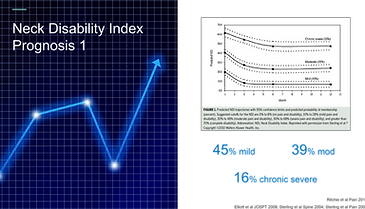
Whiplash: clinically relevant physiotherapy management
Evidenced informed overview, assessment and treatment
1 Day
8 hour
Cost: €150
Clear up
Controversy
Instantly Applicable
Clinically Relevant
Irrelevant theory avoided
-
Overview
-
Assessment
-
Treatment


Course outline:
Whiplash injuries are common and usually occur from an acceleration/deceleration injury to the neck in a traumatic event such as road traffic accidents or slips and falls.
The pathogenesis of whiplash associated disorders (WAD) is complex with evidence of patho-anatomical aspects and peripheral and central sensitisation, but the underlying mechanisms are not fully understood. WAD is best considered under the biopsychosocial model. In spite of scientific research WAD and its manifestations are at times controversial,
Despite the increased research and medical attention to WAD, 50% of those with WAD will not recover fully and will have long-term pain and disability!
The course aims to introduce and review current concepts and knowledge base around WAD, including an overview of whiplash, assessment relevant to the WAD patient and physiotherapeutic management of WAD patients. The lecture-based aspect of this course is clinically relevant. Non-relevant information is kept to a minimum. It also covers practical elements regarding assessment and treatment relevant to WAD.
Aim of the course:
– To present an evidence-informed clinically relevant overview of whiplash
– To discuss the prevalence and socioeconomic impact of whiplash
– To appreciate the historical context and controversies in whiplash
– To understand the mechanisms of whiplash injuries
– To be able to classify presentations of WAD
– To understand and utilise the Neck Disability Index in the assessment of WAD patients
– To be able to run a clinical prediction rule for prognosis of WAD
– To present clinically relevant assessment related to WAD presentation
– To present treatment concepts, evidence and current limitations for patients with WAD
– To understand the role of the multidisciplinary team in the treatment of WAD
CONTENTS
Section 1: Overview
1.Introduction
2.Definition
3.Historical context
4.WAD classification
5.Prevalence etc
6.Symptoms and signs
7.Risk factors
8.Neck disability index
9.Pain generators & pathogenesis
10.Imaging in WAD
11.Team approach
12.Medical legal aspects
Section 2: Assessment
1.Subjective, red flags
2.Examination outline
3.ROM & strength
•Rom measurement
•Muscle HHD
•Cranio-cervical flexion test
4.Neurological (WAD III)
•Reflexes
•Myotomes
•Dermatomes
•Upper limb tension test
•Spurling’s test
•Cluster of 4 (Wainner)
5.Muscle palpation & algometery
6.Joint – C1/C2 instability
7.Management overview
Section 3: Treatment
1.Treatment overview
•Evidence
•Therapeutic relationship
2.Education for WAD
•Patients’ experience
•Validation & acceptance
•Recommended education
•Coping strategies
•Education booklet
3.Exercise for WAD
•ROM
•Static neck exercises
•Deep neck flexors
•Scapular exercises
•Visual exercises
•Neuromuscular balance
4.Manual therapy: focus on TrPs